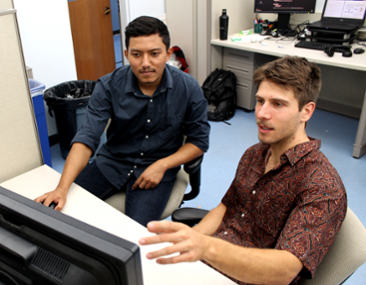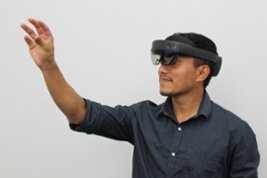Lab in Focus: Computer Science and Software Engineering Professors and students collaborate on many publications

Miami University’s CEC is very focused on allowing their students to have the chance to participate and succeed in their research. Within the Computer Science and Software Engineering department, there are multiple projects that are currently being worked on by both undergraduate and graduate students alongside professors such as Dr. Philippe Giabbanelli, an Associate Professor at Miami.
Junjiang Li finished his undergraduate degree and has published three conference articles and one journal article. Li has conducted pioneering work pertaining COVID-19, as seen in his work on the paper “Identifying Synergistic Interventions to Address COVID-19 Using a Large Scale Agent-Based Model.”
The first study for this project was performed in Fall 2020, and in this paper, Li and Dr. Giabbanelli examined the fundamental policy question: which set of interventions should we pursue to lower the number of new COVID cases?
There are a vast arsenal of interventions that policy makers can use, but using all of these may not be possible due to factors such as logistical reasons, a lack of public acceptance, or economic impact. In addition to this, interventions such as social distancing are often broadly defined and need to be made concrete, such as exactly how far away individuals must stay apart from each other.
To answer this, Li and Giabbanelli worked to use large-scale computer simulations to carry out many possible intervention sets and examined how the reductions in the number of cases could be attributed to certain methods of interventions to determine which would be best to help decrease these cases. In the end, the best set solution included mask wearing and remote work, which has since been confirmed to be the best solution since then.
In another paper titled “Returning to a Normal Life via COVID-19 Vaccines in the United States: A Large-scale Agent-Based Simulation Study,” Li and Giabbanelli continued using large-scale computer simulations to examine the impact of vaccines. The two created a comprehensive model that accounted for the two doses, the limits and abilities of a country in providing a number of doses each month, and behavioral factors pertaining to who would seek the vaccine. This study showed that the vaccination alone couldn't keep COVID-19 under control, which has since been confirmed.
Alongside these papers, Li and Giabbanelli have also been extremely successful in creating a novel method in two other conference papers as well.
Li and Giabbanelli’s paper won the best paper award in the DS-RT conference, which is prestigious in the academic world and is often given to large research universities with strong doctoral programs. An undergraduate student receiving a best paper award at an international conference is very rare, which serves as a testimony to the quality of work that was produced with this paper.
Following his work on these undergraduate projects, Li is now a graduate student at the University of Toronto, which is considered one of the most reputable institutions for computer science in 
Christopher Lutz, another undergraduate student, is continuing Li’s line of research with Giabbanelli and has already been successful with a conference publication as well as a journal article. These publications study how many costly simulations are truly needed before we can accurately make decisions, either in managing HIV (for personalized medicine regarding a single patient) or to handle COVID (over a large geographical scale).
Lutz’s work is particularly innovative, as it is at the interface of machine learning and large-scale simulations. Specifically, Lutz has been able to replace computationally expensive simulations, which take a lot of time and require powerful computers, with much cheaper proxies thanks to machine learning.
While Lutz may still be an undergraduate, he has already accepted a job offer at Raytheon Technologies, with his publication being a strong asset in landing this offer.
Similar to Lutz, Maciej Wozniak was working on machine learning and co-authored one conference publication with Dr. Giabbanelli, titled “Comparing Implementations of Cellular Automata as Images: A Novel Approach to Verification by Combining Image Processing and Machine Learning.” This publication was one of several key factors that helped Maciej land several competitive offers to pursue his doctoral studies. Starting in January, he is now a doctoral student at KTH Royal Institute of Technology in Stockholm, which is the highest ranked technical university in Sweden and is a top 100 school globally.
In his paper, Wozniak made a pioneering use of machine learning by using it to assess whether a complex model was correct. This is a difficult task, as it normally requires experts to perform extensive testing, where errors may still go unnoticed. In contrast, the use of machine learning does not take as much time for experts and can be much more comprehensive at identifying errors.
Wozniak was also engaged in an international collaboration set up by Giabbanelli with the University of Maastricht. Within this collaboration, he worked with a team of researchers to apply machine learning to the study of human behaviors in order to automatically create computer models and safely test behavioral interventions. Manuscripts originating from this international collaboration have already been submitted.
A final notable student of Giabbanelli is Alexander Freund, who has three conference publications, titled “Are We Modeling the Evidence or Our Own Biases? A Comparison of Conceptual Models Created from Reports,” “Automatically Combining Conceptual Models Using Semantic and Structural Information” and most recently, “The Necessity and Difficulty of Navigating Uncertainty to Develop an Individual-Level Computational Model.”
His latest paper received excellent reviews at a well-ranked conference, and was invited for a selective extended version by the organizers. Freund came to Miami with an interest for graph theory, but this quickly turned into a passion through his master’s thesis.
Freund now continues this work at SpaceX, which is a dream job that he landed partly thanks to the research he has done in the lab.
Giabanelli talked briefly about his project about augmented reality, which is a new development in his lab that he is excited about that is conducted by Mr. Anish Shrestha, a graduate student.
“Augmented reality is an area with a lot of growth potential so I am including it in my research on predictive models.” Giabbanelli said when asked about his interest in this topic.
Specifically, Shrestha is working with the Microsoft Hololens 2 to develop virtual environments in which modeling experts can collaborate, across the world, to jointly create new predictive models.
Another notable project that is a year in the making is a collaboration with CDC in Atlanta, in which they are developing computational models to help prevent suicide among children and adolescents.
There is one conference publication on this topic, titled "Mapping the complexity of suicide by combining participatory modeling and network science,” with the authors including Dr Giabbanelli and Miami students (Michael Galgoczy, Duc Nguyen) alongside CDC researchers.
“Our department has a very strong and growing publication record, particularly in conferences since they are the main venue in our field. The ones in which we publish are selective, often highly ranked, and ensure a timely dissemination of findings in our fast moving field. Our research strengths ultimately come from our faculty. It's important to note that our strength is not just the 'sum' of the skills of our individual faculty,” Giabbanelli said when asked about the strengths of the department relating to research.
By Gabby Benedict, CEC Reporter

